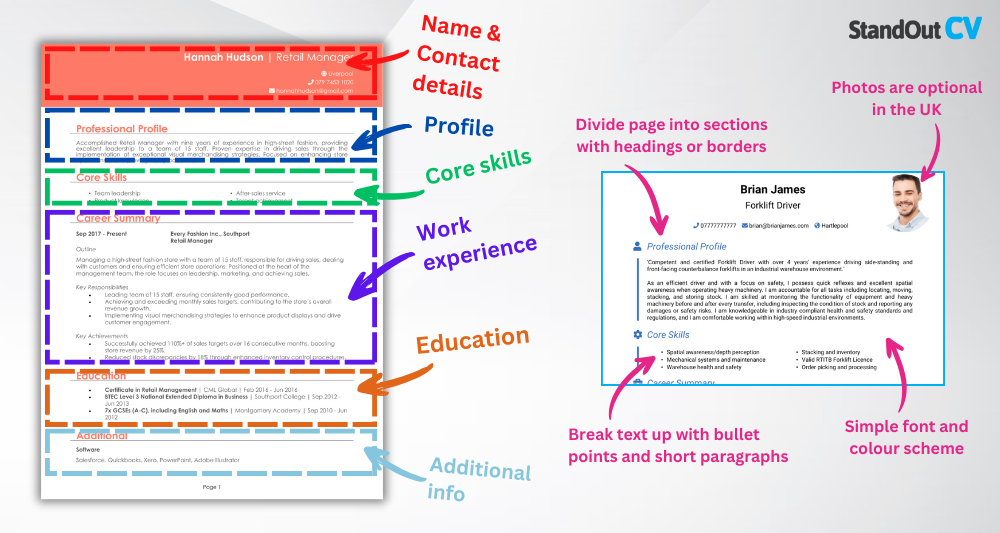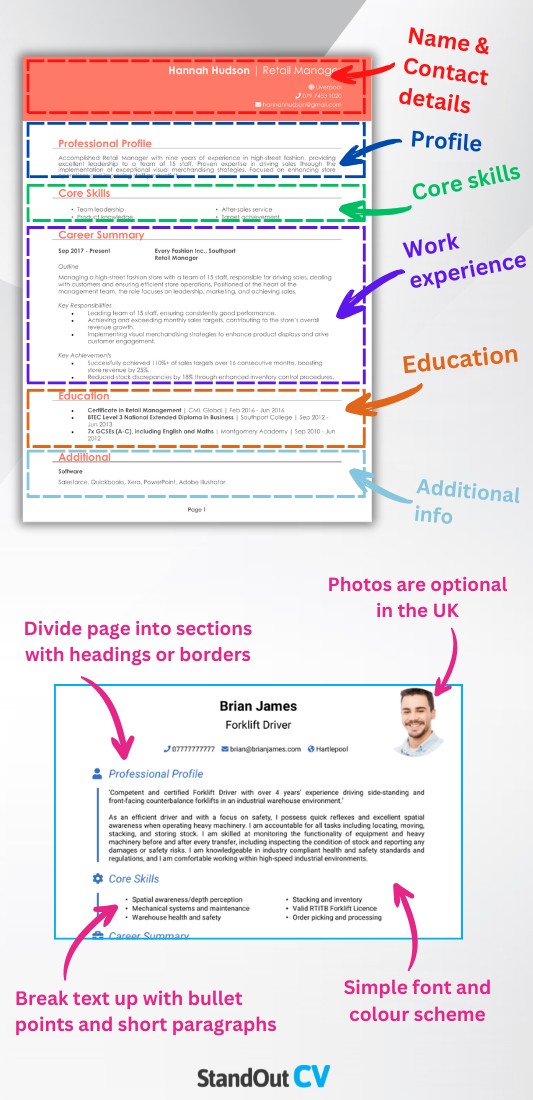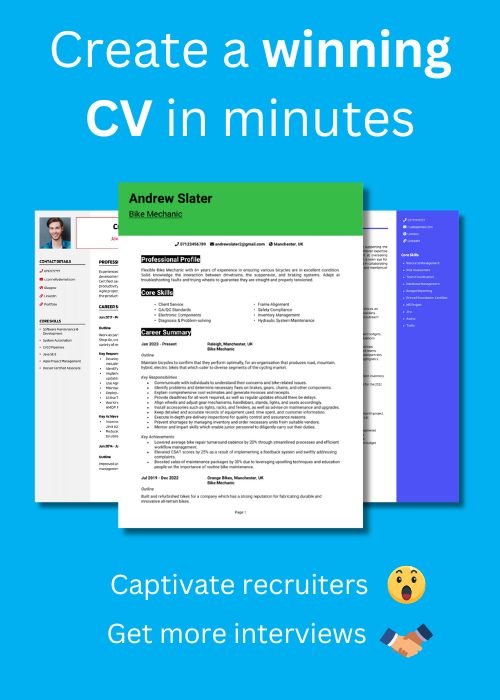You spend your time helping others untangle their thoughts – but when it comes to writing your own CV, even you might feel a little blocked. That’s normal. Turning years of professionalism and emotional intelligence into two pages of text isn’t exactly straightforward.
This guide and its Therapist CV example will help you construct an application that demonstrates your clinical experience and therapeutic style, in order to prove the value you bring to clients.
Therapist CV sample

How to write your Therapist CV
Discover how to craft a winning Therapist CV that lands interviews with this simple step-by-step guide.
A good therapist listens – but when applying for a new role, you’ll need to do the talking. Your CV should clearly outline your areas of expertise and the impact of your work. And just as you tailor treatment plans to individual clients, your CV should be adapted to each employer’s needs.
This guide will take you through each part of writing a CV, from layout to wording – so you can showcase your credentials and clinical experience with warmth and professionalism.
The correct structure and formatting for a Therapist CV


As someone who values order and structure in the therapeutic process, your CV should reflect the same sense of clarity. Recruiters want to see the progression of your experience and the scope of your clinical work at a glance – without digging through disorganised or overly dense blocks of text.
Here’s the layout to follow:
- Name and contact details – Place your name and personal details prominently at the top of your CV for quick access. Adding a photo is up to you.
- Profile – Open with a compelling overview of your skills, experience, and career goals.
- Core skills – List your key abilities in this section, focusing on those that will be most relevant to the job.
Work experience – Provide a detailed breakdown of your work history, starting with the most recent job first. - Education – List your qualifications, including degrees and relevant certifications, in reverse chronological order.
- Additional info – Use this optional space for relevant hobbies or personal pursuits that enhance your application.
For readability, use bullet points to break up text and keep key information easy to scan. Structure your CV using clear, professional headings and consistent format throughout. Stick to a simple, clean font and make sure your CV length doesn’t exceed two pages. The goal is to provide insight, not overload – the same principle that applies in any effective therapeutic relationship.
CV profile for a Therapist


Your professional profile is a recruiter’s first impression – and for a therapist, it should demonstrate the clarity you’d bring to the role. Use this space to convey your therapeutic background, the types of clients you support, and the value you bring to a service or practice.
Wherever your speciality, your CV profile should highlight your approach and show that you can build trust and adapt to complex cases in order to deliver meaningful outcomes.
Therapist CV profile examples
Profile 1
Experienced Therapist with over 15 years in clinical practice, supporting clients in hospitals, community health centres, and private practice. Specialises in delivering evidence-based interventions for anxiety, depression, and trauma, while tailoring approaches to individual needs. Proficient in using case management systems and maintaining detailed clinical notes in line with healthcare regulations. Recognised for building trust with clients, collaborating with multidisciplinary teams, and achieving positive long-term outcomes.
Profile 2
Compassionate Therapist with eight years of experience providing counselling and psychotherapy services in educational and non-profit settings. Skilled in facilitating individual and group therapy sessions, with a focus on stress management, resilience building, and emotional wellbeing. Experienced in using CBT and person-centred approaches, while maintaining safeguarding and ethical practice standards. Known for empowering clients to develop coping strategies and achieve personal growth.
Profile 3
Dedicated Therapist with three years of experience working in a private wellbeing clinic, delivering short- and long-term therapy programmes for diverse clients. Supported individuals with relationship challenges, work-related stress, and low self-esteem. Proficient in digital therapy platforms and remote session management, ensuring accessible care. Passionate about helping clients achieve improved mental health through a supportive and non-judgemental approach.
Details to put in your Therapist CV profile
Here’s what to include:
- Where you worked – Mention the types of settings you’ve worked in, such as private practice, schools, hospitals, or community health.
- Your top qualifications – Include degrees, postgraduate training, and any professional accreditations or licences.
- Essential skills – Briefly reference your key competencies, such as assessment, counselling, or treatment planning.
- Client groups or specialisms – Indicate the age groups, issues, or diagnoses you specialise in, such as trauma, anxiety, or family therapy.
- Value delivered – Explain how your work supports positive client outcomes, helps reduce risk, or contributes to service delivery.
How should you write a core skills section?


The core CV skills section is a chance to highlight your practical, job-relevant strengths in one place – but it’s not just a list of buzzwords. Focus on hard skills that relate directly to the job you’re applying for, using the job spec as a reference point.
Whether you have a background in CBT, psychodynamic therapy, solution-focused work, or another modality, this section should reflect your therapeutic skillset and the interventions you’re trained to use. Tailoring this section can make a big difference – especially if a job calls for certain techniques or client experience.
Key skills for a Therapist CV
- Client Assessment and Intake – Conducting initial evaluations to understand clients’ mental health history, current concerns, and treatment goals.
- Therapeutic Intervention Delivery – Applying evidence-based approaches such as CBT, ACT, or person-centred therapy tailored to individual needs.
- Treatment Planning and Progress Monitoring – Developing structured plans and regularly reviewing outcomes to ensure therapeutic effectiveness.
- Confidential Record Keeping – Maintaining accurate, confidential notes and adhering to ethical and legal documentation standards.
- Crisis Intervention and Risk Management – Responding to high-risk situations with appropriate safeguarding and escalation procedures.
- Specialist Area Expertise – Providing targeted therapy for specific issues such as trauma, addiction, anxiety, or relationship difficulties.
- Client Engagement and Rapport Building – Establishing a safe, trusting therapeutic relationship that supports openness and progress.
- Ethical Practice and Regulatory Compliance – Adhering to professional codes of conduct and relevant healthcare regulations.
- Supervision and Reflective Practice – Participating in regular clinical supervision and reflective exercises to enhance therapeutic skills.
- Psychoeducation and Resource Sharing – Educating clients about psychological concepts and providing tools to support coping and recovery.
Writing about your work experience


As a therapist, your work experience isn’t just about where you’ve worked – it’s about how you’ve made a difference. This section should show how you supported clients, worked within teams, and contributed to outcomes. It should reflect both your day-to-day responsibilities and the broader impact of your role.
List your experience in reverse chronological order. For each role, begin with a short paragraph describing the organisation, your position, and the context of your work. Then use bullet points to break down your clinical responsibilities and achievements in a way that’s easy to scan.
Formatting your job history for your CV

- Outline – Provide context about the employer, setting, and client base. Mention the type of therapeutic work carried out and who you reported to.
- Responsibilities – Use action words like “facilitated” and “implemented.” For example: “facilitated group sessions for clients with depression” or “implemented risk assessment protocols for high-need referrals.”
- Achievements – Emphasise outcomes, improvements in client wellbeing, or service contributions. Use data if available – e.g. reduction in waiting times, increased client engagement, or successful audit results.
Work experience samples for Therapists
Therapist | Willowbrook Health Trust
Outline
Provided therapeutic support within an NHS community mental health team, treating a wide range of clients presenting with mild to severe mental health conditions. Worked collaboratively with psychiatrists, social workers, and support staff to ensure continuity of care.
Responsibilities
- Conducted assessments and developed personalised treatment plans for patients
- Delivered one-to-one therapy sessions using CBT and integrative approaches
- Maintained accurate case notes and documentation in line with NHS protocols
- Facilitated group sessions focusing on coping strategies and emotional regulation
- Attended multidisciplinary meetings to review progress and coordinate care
Achievements
- Reduced client waiting list times by 20% by optimising appointment scheduling
- Achieved positive clinical outcomes for 80% of caseload through structured interventions
- Contributed to service improvements recognised in a regional NHS quality review
Therapist | Havenwell Counselling Services
Outline
Delivered counselling services for a non-profit organisation supporting vulnerable individuals including survivors of abuse and those facing homelessness. Ensured therapy was accessible, ethical, and adapted to complex personal circumstances.
Responsibilities
- Provided trauma-informed counselling tailored to individual client needs
- Ran group workshops focused on self-esteem, confidence, and relationship building
- Supported safeguarding processes by liaising with social services and local agencies
- Kept comprehensive records in secure digital case management systems
- Delivered outreach therapy sessions in schools and community centres
Achievements
- Helped 70% of clients report improved coping skills within six sessions
- Secured additional grant funding by contributing outcome data to funding proposals
- Built referral partnerships with three local charities to increase service reach
Therapist | Elmhurst Wellbeing Clinic
Outline
Worked in a private practice setting offering therapy to adults and young people on a self-referral basis. Provided flexible therapy plans and online sessions to meet the needs of a diverse client base.
Responsibilities
- Completed intake assessments and recommended tailored therapy approaches
- Delivered both short-term solution-focused sessions and longer-term support
- Used secure digital platforms to provide online therapy to remote clients
- Monitored progress and adapted therapeutic strategies where necessary
- Maintained confidentiality and adherence to GDPR and professional codes of conduct
Achievements
- Achieved a 95% client satisfaction rating based on anonymous post-therapy surveys
- Expanded clinic services by piloting a successful online therapy programme
- Supported over 50 clients annually in achieving improved mental health outcomes
How to write your education section


In a clinical profession like therapy, education matters – but this section doesn’t need to be overly long. Just make sure your academic and professional credentials are clearly listed, especially if they’re relevant to a specific modality or regulated body.
List your most recent or highest qualification first, and include any postgraduate training, therapy-specific diplomas, or registration-based learning. If you’ve completed CPD or short courses in specialised areas (e.g. trauma therapy, safeguarding, or supervision), you can include those too – especially if they’re requested in the job advert.
Recommended qualifications for Therapists
- Postgraduate Diploma or MSc in Counselling or Psychotherapy – Core clinical training required for most therapist roles
- BACP/UKCP/HPCP Accreditation or Registration – Confirms professional standards and eligibility to practise
- Degree in Psychology or Mental Health – Useful academic foundation for many therapy training routes
- Safeguarding and Risk Assessment Training – Especially important when working with vulnerable groups
- Certificate in CBT, EMDR, or Play Therapy – Shows additional modality expertise and specialist intervention training





